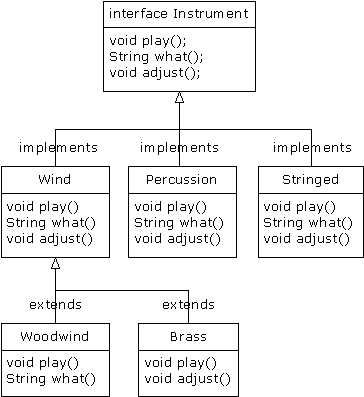标签:end 编译器 rcu 技术 tom 程序员 string images util
“interface”(接口)关键字使抽象的概念更深入了一层。我们可将其想象为一个“纯”抽象类。它允许创
建者规定一个类的基本形式:方法名、自变量列表以及返回类型,但不规定方法主体。接口也包含了基本数
据类型的数据成员,但它们都默认为static 和final。接口只提供一种形式,并不提供实施的细节。
接口这样描述自己:“对于实现我的所有类,看起来都应该象我现在这个样子”。因此,采用了一个特定接
口的所有代码都知道对于那个接口可能会调用什么方法。这便是接口的全部含义。所以我们常把接口用于建
立类和类之间的一个“协议”。有些面向对象的程序设计语言采用了一个名为“protocol”(协议)的关键
字,它做的便是与接口相同的事情。
为创建一个接口,请使用interface 关键字,而不要用class。与类相似,我们可在interface 关键字的前
面增加一个public 关键字(但只有接口定义于同名的一个文件内);或者将其省略,营造一种“友好的”状
态。
为了生成与一个特定的接口(或一组接口)相符的类,要使用implements(实现)关键字。我们要表达的意
思是“接口看起来就象那个样子,这儿是它具体的工作细节”。除这些之外,我们其他的工作都与继承极为
相似。下面是乐器例子的示意图:

具体实现了一个接口以后,就获得了一个普通的类,可用标准方式对其进行扩展。
可决定将一个接口中的方法声明明确定义为“public”。但即便不明确定义,它们也会默认为public。所以
在实现一个接口的时候,来自接口的方法必须定义成public。否则的话,它们会默认为“友好的”,而且会
限制我们在继承过程中对一个方法的访问——Java 编译器不允许我们那样做。
在Instrument 例子的修改版本中,大家可明确地看出这一点。注意接口中的每个方法都严格地是一个声明,
它是编译器唯一允许的。除此以外,Instrument5 中没有一个方法被声明为public,但它们都会自动获得
public 属性。如下所示:
//: Music5.java // Interfaces 173 import java.util.*; interface Instrument5 { // Compile-time constant: int i = 5; // static & final // Cannot have method definitions: void play(); // Automatically public String what(); void adjust(); } class Wind5 implements Instrument5 { public void play() { System.out.println("Wind5.play()"); } public String what() { return "Wind5"; } public void adjust() {} } class Percussion5 implements Instrument5 { public void play() { System.out.println("Percussion5.play()"); } public String what() { return "Percussion5"; } public void adjust() {} } class Stringed5 implements Instrument5 { public void play() { System.out.println("Stringed5.play()"); } public String what() { return "Stringed5"; } public void adjust() {} } class Brass5 extends Wind5 { public void play() { System.out.println("Brass5.play()"); } public void adjust() { System.out.println("Brass5.adjust()"); } } class Woodwind5 extends Wind5 { public void play() { System.out.println("Woodwind5.play()"); } public String what() { return "Woodwind5"; } } public class Music5 { 174 // Doesn‘t care about type, so new types // added to the system still work right: static void tune(Instrument5 i) { // ... i.play(); } static void tuneAll(Instrument5[] e) { for(int i = 0; i < e.length; i++) tune(e[i]); } public static void main(String[] args) { Instrument5[] orchestra = new Instrument5[5]; int i = 0; // Upcasting during addition to the array: orchestra[i++] = new Wind5(); orchestra[i++] = new Percussion5(); orchestra[i++] = new Stringed5(); orchestra[i++] = new Brass5(); orchestra[i++] = new Woodwind5(); tuneAll(orchestra); } } ///:~ 代码剩余的部分按相同的方式工作。我们可以自由决定上溯造型到一个名为Instrument5 的“普通”类,一 个名为Instrument5 的“抽象”类,或者一个名为Instrument5 的“接口”。所有行为都是相同的。事实 上,我们在tune()方法中可以发现没有任何证据显示Instrument5 到底是个“普通”类、“抽象”类还是一 个“接口”。这是做是故意的:每种方法都使程序员能对对象的创建与使用进行不同的控制。
标签:end 编译器 rcu 技术 tom 程序员 string images util
原文地址:http://www.cnblogs.com/yxh1008/p/6159343.html